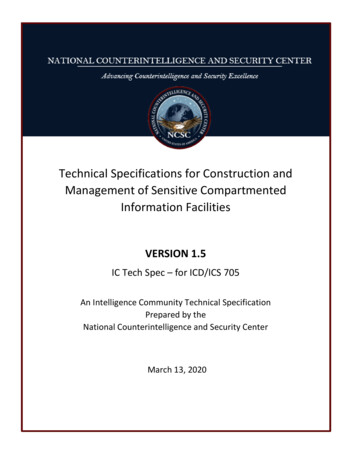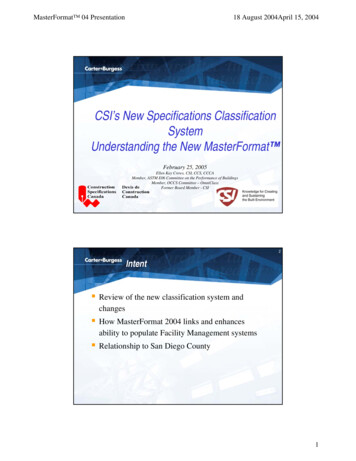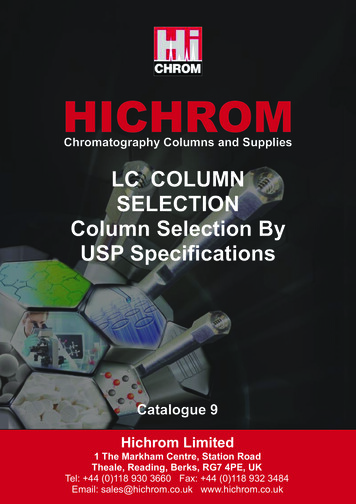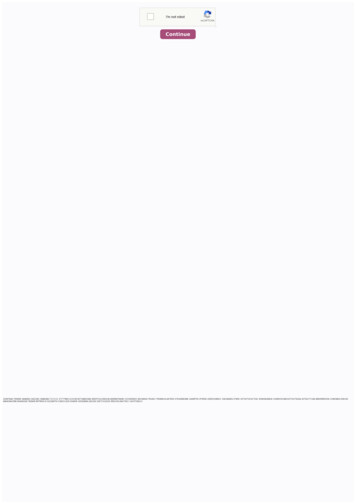
Transcription
Technical Specifications for Construction andManagement of Sensitive CompartmentedInformation FacilitiesVERSION 1.5IC Tech Spec – for ICD/ICS 705An Intelligence Community Technical SpecificationPrepared by theNational Counterintelligence and Security CenterMarch 13, 2020
This page intentionally left blank.
OFFICE OF THE DIRECT OR OF NATIONAL INTELLIGENCEDIRECT OR OF THE NATIONAL COUNTERINTELLIGENCE AND SECURITY CENTERWASHINGTO N, DC 20511NCSC 19-686MEMORANDUM FOR:DistributionSUBJECT:Technical Specifications for Construction and Managementof Sensitive Compartmented Information Facilities, Version1.5A. (U) D/NCSC Memo NCSC-19-329, Technical Specificationsfor Construction and Management of Sensitive CompartmentedInformation Facilities, Version 1.4, 28 Sep 17 (U)B. (U) Technical Specifications, Version 1.4, 28 Sep 17 (U)C. (U) ICD 705, Sensitive Compartmented Information Facilities,26 May 10 (U)D. (U) ICS 705-01, Physical and Technical Standards for SensitiveCompartmented Information Facilities, 27 Sep 10 (U)E. (U) ICS 705-02, Standards for the Accreditation and ReciprocalUse of Sensitive Compartmented Information Facilities, 22Dec 16 (U)REFERENCES:This memorandum promulgates Version 1.5 of the Technical Specification forConstruction and Management of Sensitive Compartmented Information Facilities to theIntelligence Community, which replaces Version 1.4 (Ref A), effective immediately.The Technical Specifications was designed to be a living document that enables periodicupdates to keep up with changing and emerging technology. Based on input from theIntelligence Community (IC) and as a result of a cooperative effort by physical and technicalexperts from IC elements and our industrial partners, this Version 1.5 of the TechnicalSpecifications has been updated to meet the needs of the community and enhance thestandards identified in ICS 705-01, Physical Security Standards for Sensitive CompartmentedInformation Facilities (Ref C) and ICS 705-02, Standards for the Accreditation andReciprocal Use of Sensitive Compartmented Information Facilities (Ref D).Questions may be directed to the National Counterintelligence and Security Center'sSpecial Security .William R. EvaninaDate
UNCLASSIFIEDSUBJECT: Technical Specifications for Construction and Management of SensitiveCompartmented Information Facilities, Version 1.5Distribution:Secretary of State, Department of StateSecretary of the Treasury, Department of the TreasurySecretary of Defense, Department of DefenseAttorney General, Department of JusticeSecretary of the Interior, Department of the InteriorSecretary of Agriculture, Department of AgricultureSecretary of Commerce, Department of CommerceSecretary of Labor, Department of LaborSecretary of Health and Human Services, Department of Health and Human ServicesSecretary of Housing and Urban Development, Department of Housing and UrbanDevelopment Secretary of Transportation, Department of TransportationSecretary of Energy, Department of EnergySecretary of Education, Department of EducationSecretary of Veterans Affairs, Department of Veterans AffairsSecretary of Homeland Security, Department of Homeland SecurityAdministrator, Executive Office of the PresidentAdministrator, Environmental Protection AgencyDirector, Office of Management and BudgetUnited States Trade RepresentativeAdministrator, Small Business AdministrationDirector, National Drug Control PolicyDirector, Central Intelligence AgencyAdministrator, Equal Employment Opportunity CommissionChairman, Federal Communications CommissionChairman, Federal Maritime CommissionChairman, Federal Reserve SystemChairman, Federal Trade CommissionAdministrator, General Services AdministrationAdministrator, National Aeronautics and Space AdministrationArchivist, National Archives and Records AdministrationDirector, National Science FoundationChairman, Nuclear Regulatory CommissionDirector, Office of Government EthicsChairman, Privacy and Civil Liberties Oversight BoardChairman, Security and Exchange CommissionDirector, Selective Service SystemCommissioner, Social Security AdministrationAdministrator, United States Agency for International DevelopmentUnited States Postal ServiceChairman, United States International Trade CommissionDirector, United States Peace CorpsiiUNCLASSIFIED
UNCLASSIFIEDSUBJECT: Technical Specifications for Construction and Management of SensitiveCompartmented Information Facilities, Version 1.5Distribution, cont.:Office of the Chief Administrative OfficeriiiUNCLASSIFIED
Change HistoryChange HistoryRev. .204/23/1264ChangesBanner Graphic, Version, DateAdded note to warn users ofclassification when associating threatinformation and facility location.Re-worded approval of CAs todesignate the AO as the primaryapproval authority of CompartmentedAreas within SCIFs.Changed “Type X Gypsum” to“wallboard” to remove the standard offire resistant gypsum and permit use ofother wallboard types.Changed references to wall designdrawings to “suggested” wall types toenable variety of wall constructiontechniques to meet the securitystandards.Added explanation to glue and screwplywood to ceiling and floor to clarifystandard. Stud placement changed to 16on center to match drawing and correcterror.Added statement to finish wall andpaint from true floor to true ceiling inWalls B and C to clarify and equalType A Wall.Replaced drawings to reflect“suggested” wall construction methodsand remove references to “Type Xgypsum wallboard”.Replaced drawings to reflect“suggested” wall construction methodsand remove references to “Type Xgypsum wallboard”.Updated Federal InformationProcessing Standards (FIPS) encryptionstandards and certification to remove astandard that could not be met bycommercial alarm systems.Replaced FIPS 140-2 with AdvancedEncryption Standard (AES) to removea standard that could not be met bycommercial alarm SEWGPTSEWGPTSEWGPTSEWGPTSEWGPTSEWG
Change HistoryRev. # klistCAChecklistSCIF Co-UseRequest andMOA 71.303/26/1558-59ChangesRemoved references to “inspectablespace” as requested by the TEMPESTAdvisory Group (TAG).Removed references to ed parenthetical reference to cell PTSEWGphones and Bluetooth.Replaced Compartmented AreaPTSEWGChecklist to reflect IC standards.Replaced Co-Use and MOA Form toPTSEWGinclude “joint-use” statements.Banner change, version, dateAppended “D/NCSC Memorandum”“Appended Change History”Chapter 2.A (2)(a) Added: “NOTE”regarding prefabricated modular SCIFs.Chapter 3.CCorrected wording to match walldrawings on p.21.Chapter 3.G (7)(c.4) Correction andaddition of guidance on vents and ductsperimeter protection.Reformatted wall types to reflectcorrect architectural graphics forprescribed materials.Chapter 7.A (2)(d)Added requirement for HSS GPTSEWGChapter 7.A (2)(k) Changed toreflect restrictions on dissemination ofinstallation plans.PTSEWGChapter 7.A (3)(a.2)Addedexception that sensors must be locatedwithin SCIF perimeter.Chapter 7.A (3)(b.7.e) Replaced“Zones” with “IDE sensor points”.Chapter 7.A (3)(c.1)Addedlanguage for approval authority.Chapter 7.A (3)(c.2)Addedlanguage for integrated IDS andRemote Access.Chapter 7.A (3)(c.2)Added systemapplication software requirements.Replaced “access/secure” with“arm/disarm” throughout.PTSEWGvPTSEWGPTSEWGPTSEWGPTSEWGPTSEWG
Change HistoryRev. # 19Page58ChangesChapter 7.B (2)Added “Arecord shall be maintained thatidentifies the person responsible fordisarming the system”.87Chapter 12.G (2)Changed Section header to read“Inspections/Reviews, added samewhere the term “inspection” or“review” used. The responsibility toperform as such was changed from “ICelement head” to the AO, or designee.SCIF Co-Use Appended Co-Use Request and MOARequest and FormMOA FormCoverBanner change, version, datei-iiiAppended “D/NCSC Memorandum”iv-vii“Appended Change History”1Chapter 1.B.2Added SAPF Language12Chapter 3.E.1.bAdded egress device language60Chapter 7.C.1.cAdded, “ IAW UL 2050 requirements(60 minutes)”71-74Chapter 10 Revised75-76Chapter 11.B.5Added sub-bullets to address CNSSI500290-91Chapter 12.L1/2/7Added clarification language91-92Chapter 12.M.4Synchronized bullets3-4Chapter 2.A.3.aAdded clarification language5-6Chapter 2.C.2Defined CA Types8Chapter 3. Added Pre-ConstructionChecklist language13-15Chapter 3.EExpanded SCIF Door Criteria30Chapter 4.E.2Added reference to InspectableMaterials EWGPTSEWGPTSEWGPTSEWGPTSEWG
Change .511/13/19901.511/13/1995-971.511/13/1998Chapter 5.AAdded language in ApplicabilityChapter 6.A.1.aAdded exception languageChapter 10Changed “CSA” to “AO” whereappropriateChapter 12.G.8Added TSCM language toInspections/ReviewsChapter 12.N/O/PAdded CUA instructionsChapter 13Updated FFC and added CUA Guideand Cancellation Forms, InspectableMaterials Checklist, PreConstruction ChecklistviiPTSEWGPTSEWGPTSEWGPTSEWGPTSEWGPTSEWG
This page intentionally left blank.viii
Table of ContentsTable of ContentsChapter 1. Introduction 1A. Purpose 1B. Applicability 1Chapter 2. Risk Management . 3A. Analytical Risk Management Process 3B. Security in Depth (SID) . 4C. Compartmented Area (CA) . 5Chapter 3. Fixed Facility SCIF Construction . 8A. Personnel . 8B. Construction Security . 9C. Perimeter Wall Construction Criteria . 10D. Floor and Ceiling Construction Criteria . . . 13E. SCIF Door Criteria . 13F. SCIF Window Criteria . . . .15G. SCIF Perimeter Penetrations Criteria . 15H. Alarm Response Time Criteria for SCIFs within the U.S. 17I. Secure Working Areas (SWA) . 17J. Temporary Secure Working Area (TSWA) . 18Chapter 4. SCIFs Outside the U.S. and NOT Under Chief of Mission (COM) Authority . 23A. General 23B. Establishing Construction Criteria Using Threat Ratings . 23C. Personnel . 26D. Construction Security Requirements . 27E. Procurement of Construction Materials . 30F. Secure Transportation for Construction Material 31G. Secure Storage of Construction Material 32H. Technical Security . 33I. Interim Accreditations 33Chapter 5. SCIFs Outside the U.S. and Under Chief of Mission Authority 35A. Applicability 35B. General Guidelines . 35C. Threat Categories 36D. Construction Requirements 36E. Personnel . 38F. Construction Security Requirements . 39G. Procurement of Construction Materials . 42H. Secure Transportation for Construction Material 43I. Secure Storage of Construction Material 44ix
Table of ContentsJ. Technical Security . .44K. Interim Accreditations 45Chapter 6. Temporary, Airborne, and Shipboard SCIFs . 46A. Applicability . 46B. Ground-Based T-SCIFs . 46C. Permanent and Tactical SCIFS Aboard Aircraft . 48D. Permanent and Tactical SCIFs on Surface or Subsurface Vessels 50Chapter 7. Intrusion Detection Systems (IDS) 56A. Specifications and Implementation Requirements . 56B. IDS Modes of Operation . 61C. Operations and Maintenance of IDS 63D. Installation and Testing of IDS 64Chapter 8. Access Control Systems (ACS) 66A. SCIF Access Control . 66B. ACS Administration 67C. ACS Physical Protection . 67D. ACS Recordkeeping 67. E. Using Closed Circuit Television (CCTV) to Supplement ACS . 68F. Non-Automated Access Control . 68Chapter 9. Acoustic Protection 70A. Overview . 70B. Sound Group Ratings . 70C. Acoustic Testing 70D. Construction Guidance for Acoustic Protection . 71E. Sound Transmission Mitigations . 71Chapter 10. Portable Electronic Devices with Recording Capabilities and EmbeddedTechnologies (PEDs/RCET) . . 74A. Approved Use of PEDs/RECET in a SCIF 74B. Prohibitions . 75C. PED/RCET Risk Levels . 75D. Risk Mitigation 76Chapter 11. Telecommunications Systems . 78A. Applicability 78B. Unclassified Telephone Systems . 78C. Unclassified Information Systems . 80D. Using Closed Circuit Television (CCTV) to Monitor the SCIF Entry Point(s) 80E. Unclassified Wireless Network Technology . 80F. Environmental Infrastructure Systems 81G. Emergency Notification Systems 81x
Table of ContentsH. System Access 82I. Unclassified Cable Control . 82J. Protected Distribution Systems 83K. References .83Chapter 12. Management and Operations 86A. Purpose 86B. SCIF Repository . 86C. SCIF Management . . 87D. SOPs . . 88E. Changes in Security and Accreditation . . 89F. General . 89G. Inspections/Reviews 90H. Control of Combinations . 90I. De-Accreditation Guidelines . . 91J. Visitor Access . 91K. Maintenance . . 93L. IDS and ACS Documentation Requirements . . 93M. Emergency Plan . 94N. SCIF Co-Use and Joint Use . . 95O. CUA Form and Instructions . . 96P. CUA Cancellation. . 97Chapter 13. Forms and Plans 98Fixed Facility ChecklistTEMPEST ChecklistCompartmented Area ChecklistShipboard ChecklistSubmarine ChecklistAircraft/UAV ChecklistSCIF Co-Use/Joint-Use RequestSCIF Co-Use/Joint-Use Request Users GuideCancellation of SCIF Co-Use/Joint-UsePre-Construction ChecklistConstruction Security Plan (CSP)Inspectable Materials Checklistxi
This page intentionally left blank.xii
Chapter 1IntroductionChapter 1. IntroductionA. PurposeThis Intelligence Community (IC) Technical Specification sets forth the physical andtechnical security specifications and best practices for meeting standards of IntelligenceCommunity Standard (ICS) 705-01 (Physical and Technical Standards for SensitiveCompartmented Information Facilities). When the technical specifications herein are appliedto new construction and renovations of Sensitive Compartmented Information Facilities(SCIFs), they shall satisfy the standards outlined in ICS 705-01 to enable uniform andreciprocal use across all IC elements and to assure information sharing to the greatest extentpossible. This document is the implementing specification for Intelligence CommunityDirective (ICD) 705 (Sensitive Compartmented Information Facilities), ICS 705-01, and ICS705-02 (Standards for Accreditation and Reciprocal Use of Sensitive CompartmentedInformation Facilities.The specifications contained herein will facilitate the protection of Sensitive CompartmentedInformation (SCI) against compromising emanations, inadvertent observation and disclosureby unauthorized persons, and the detection of unauthorized entry.B. ApplicabilityIC Elements shall fully implement this standard within 180 days of its signature.1. SCIFs that have been de-accredited but controlled at the SECRET level (IAW 32Code of Federal Regulations (CFR) parts 2001 and 2004) for less than one year maybe re-accredited. The IC SCIF repository shall indicate that the accreditation wasbased upon the previous standards.2. When the technical specifications herein have been applied to new construction,renovations, and operation of Special Access Program Facilities (SAPFs), thosefacilities shall satisfy the standards outlined in ICD 705 to enable uniform use acrossall IC elements for accreditation by IC elements as a Sensitive CompartmentedInformation Facility.a) Accreditation of a SAPF as a SCIF will be based upon a review of all requiredSCIF construction documentation to ensure all ICD 705 requirements weremet in the construction, maintenance, and operation of the SAPF.b) The Accrediting Official (AO) will conduct a review of all SAPFaccreditation documentation for compliance with the technical specificationsherein.(1) If all required documentation is available and correct, the AO will issueSCIF accreditation.(2) If all required documentation is not available and correct, or waivers havebeen authorized, the AO is not required to issue SCIF accreditation.1
Chapter 1Introductionc) If the facility is to be maintained as a SAPF and co-utilized as a SCIF, thesecurity posture of the facility will be to the highest requirement of the two.(1) The AO may issue a more restrictive accreditation based upon the SCIrequirements associated with the new SCIF accreditation. For example, 5minute response versus 15 minutes, or Closed Storage versus OpenStorage.(2) Program indoctrination will be coordinated as part of the co-utilizationagreement. Compartmented Areas may be utilized, but no other subdivision of the facility will be permitted. Facilities requiring additionalprotections are not suitable for co-utilization.2
Chapter 2Risk ManagementChapter 2. Risk ManagementA. Analytical Risk Management Process1. The Accrediting Official (AO) and the Site Security Manager (SSM) should evaluateeach proposed SCIF for threats, vulnerabilities, and assets to determine the most efficientcountermeasures required for physical and technical security. In some cases, based uponthat risk assessment, it may be determined that it is more practical or efficient to mitigatea standard. In other cases, it may be determined that additional security measures shouldbe employed due to a significant risk factor.2. Security begins when the initial requirement for a SCIF is known. To ensure theintegrity of the construction and final accreditation, security plans should be coordinatedwith the AO before construction plans are designed, materials ordered, or contracts let.a) Security standards shall apply to all proposed SCI facilities and shall becoordinated with the AO for guidance and approval. Location of facilityconstruction and or fabrication does not exclude a facility from security standardsand or review and approval by the AO. SCI facilities include but are not limitedto fixed facilities, mobile platforms, prefabricated structures, containers, modularapplications or other new or emerging applications and technologies that maymeet performance standards for use in SCI facility construction.NOTE: Advertised claims by manufactures that their product(s), to includemobile platforms, prefabricated structures, containers and modular structures arebuilt to SCIF standards and can be accredited without modification may not beaccurate. AOs are responsible for ensuring security controls spelled out in theICD/ICS 705 series and this document are implemented to protect the securityintegrity of the proposed SCIF prior to accreditation.b) Mitigations are verifiable, non-standard methods that shall be approved by theAO to effectively meet the physical/technical security protection level(s) of thestandard. While most standards may be effectively mitigated via non-standardconstruction, additional security countermeasures and/or procedures, somestandards are based upon tested and verified equipment (e.g., a combination lockmeeting Federal Specification FF-L 2740) chosen because of special attributesand could not be mitigated with non-tested equipment. The AO’s approval isdocumented to confirm that the mitigation is at least equal to thephysical/technical security level of the standard.c) Exceeding a standard, even when based upon risk, requires that a waiver beprocessed and approved in accordance with ICD 705.3. The risk management process includes a critical evaluation of threats, vulnerability,and assets to determine the need and value of countermeasures. The process may includethe following:a) Threat Analysis. Assess the capabilities, intentions, and opportunity of anadversary to exploit or damage assets or information. For SCI Facilities underChief of Mission (COM) authority or established on a permanent or temporary3
Chapter 2Risk Managementbasis within or on U.S. diplomatic facilities/compounds, use the OverseasSecurity Policy Board (OSPB), Security Environment Threat List (SETL) todetermine technical threat to a location. When evaluating for TEMPEST, theCertified TEMPEST Technical Authorities (CTTA) shall use the NationalSecurity Agency Information Assurance (NSA IA) list as an additional resourcefor specific technical threat information. NOTE: These threat documents areclassified. Associating the threat level or other threat information with the SCIFlocation (including country, city, etc.) will normally carry the same classificationlevel identified in the threat document. Ensure that SCIF planning documents anddiscussions that identify threat with the country or SCIF location are protectedaccordingly. It is critical to identify other occupants of common and adjacentbuildings. (However, do not attempt to collect information against U.S. personsin violation of Executive Order (EO) 12333.) In areas where there is a diplomaticpresence of high and critical technical threat countries, additionalcountermeasures may be necessary.b) Vulnerability Analysis. Assess the inherent susceptibility to attack of aprocedure, facility, information system, equipment, or policy.c) Probability Analysis. Assess the probability of an adverse action, incident, orattack occurring.d) Consequence Analysis. Assess the consequences of such an action (expressedas a measure of loss, such as cost in dollars, resources, programmaticeffect/mission impact, etc.).B. Security in Depth (SID)1. SID describes the factors that enhance the probability of detection before actualpenetration to the SCIF occurs. The existence of a layer or layers of security that offermitigations for risks may be accepted by the AO. An important factor in determining riskis whether layers of security already exist at the facility. If applied, these layers may,with AO approval, alter construction requirements and extend security alarm responsetime to the maximum of 15 minutes. Complete documentation of any/all SID measuresin place will assist in making risk decisions necessary to render a final standards decision.2. SID is mandatory for SCIFs located outside the U.S. due to increased threat.3. The primary means to achieve SID are listed below and are acceptable. SID requiresthat at least one of the following mitigations is applied:a) Military installations, embassy compounds, U.S. Government (USG)compounds, or contractor compounds with a dedicated response force of U.S.persons.b) Controlled buildings with separate building access controls, alarms, elevatorcontrols, stairwell controls, etc., required to gain access to the buildings orelevators. These controls shall be fully coordinated with a formal agreement ormanaged by the entity that owns the SCIF.4
Chapter 2Risk Managementc) Controlled office areas adjacent to or surrounding SCIFs that are protected byalarm equipment installed in accordance with manufacturer’s instructions. Thesecontrols shall be fully coordinated with a formal agreement or managed by theentity that owns the SCIF.d) Fenced compounds with access controlled vehicle gate and/or pedestrian gate.e) The AO may develop additional strategies to mitigate risk and increaseprobability of detection of unauthorized entry.C. Compartmented Area (CA)1. DefinitionA CA is an area, room, or a set of rooms within a SCIF that provides controlledseparation between control systems, compartments, sub-compartments, or ControlledAccess Programs.2. CA Typesa) Type I CAs are intended for workstation environments that are used to view andprocess compartmented information. These areas may be comprised of open bays,open spaces, or a set of rooms with multiple cubicles in an accredited SCIF. Withinthese areas, compartmented information may be securely viewed and/or processed viaan approved computer workstation by authorized personnel. Workstations in theseenvironments may include computers with single or multiple monitors. When monitorpositioning alone will not adequately protect the material from unauthorized viewing,i.e., shoulder surfing, polarized privacy screens shall be used. Compartmented datashall never be openly displayed on a monitor that faces a primary door or commonwork area. In addition to processing compartmented information on approvedcomputer workstations, Type I CAs may also include the use of printers, copiers, andscanners if appropriate procedures for control of hard copy material have beenestablished and approved by the AO. No storage or discussion is authorized, logicaland/or physical.b) Type II CAs are areas where discussions of compartmented information may takeplace. If so equipped and approved, compartmented information may also be viewedand processed. This CA comprises a room, e.g., office or conference room, inside anaccredited SCIF where compartmented discussions may be held by authorizedpersonnel. All Type II CAs must meet existing sound transmission class (STC)requirements per ICS 705-1 to ensure that the room or office retains sound within itsperimeter. In addition to compartmented discussions, Type II CAs may be used forsecure video teleconferencing (SVTC) and related communication conferencing andthe use of secure telephones for compartmented discussions. The use of printers,scanners, fax, copiers, and the secure transfer of data to approved removable mediarequire prior approval. No storage is authorized, logical and/or physical.c) Type III: A restricted discussion area used for viewing, processing, printing,copying, storage and control of accountable compartmented information. This CA is5
Chapter 2Risk Managementintended for storing and retaining compartmented information when accountabilityand strict control of compartmented program information is required. This includes,but is not limited to: notes, briefs, slides, electronic presentations, analytic papers,removable hard drives, field packs, thumb drives, laptops, personal electronic devices(PEDs) (see Chapter 10) or hand-held devices that store compartmented information.In addition to the storage of compartmented material in a GSA-approved container,Type III CAs may be used for processing compartmented information on approvedcomputer workstations; the use of printers, scanners, and copiers; the secure transferof data to approved removable media; the use of secure facsimile machines; and theuse of secure telephone equipment (STE) for compartmented discussions. Allpersonnel residing within or who have unfettered access to a Type III CA must beformally briefed into all compartments that reside within the Type III CA. Visitorsare permitted within Type III areas only when all compartmented information (forwhich the visitor is not briefed) is stored within containers, out of sight, and nocompartmented discussions occur.3. Requirementsa) The CA shall be approved by the AO with the concurrence of the CA ProgramManager or designee. The CA Checklist (Chapter 13) shall be used to requestapproval.b) Any construction or security requirements above those listed herein requireprior approval from the element head as described in ICS 705-2.4. Access Controla) Access control to the CA may be accomplished by visual recognition ormechanical/electronic access control devices.b) Spin-dial combination locks shall not be installed on CA doors.c) Independent alarm systems shall not be installed in a CA.5. Visual Protection of CA WorkstationsIf compartmented information will be displayed on a computer terminal or group ofterminals in an area where everyone is not accessed to the program, the followingmeasures may be applied to reduce the ability of “shoulder surfing” or inadvertentviewing of compartmented information: Position the computer screen away from doorway/cub
DIRECT OR OF THE NATIONAL COUNTERINTELLIGENCE AND SECURITY CENTER WASHINGTO N, DC 20511 . NCSC 19-686 . MEMORANDUM FOR: SUBJECT: REFERENCES: Distribution Technical Specifications for Construction and Management of Sensitive Compartmented Information Facilities, Version 1.5 . A.(U)D/NCSCMemoNCSC-19-329, Technical Specifications










